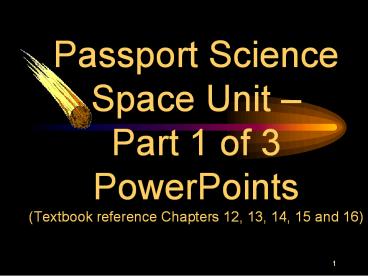Passport Science Space Unit PowerPoint PPT Presentation
1 / 33
Title: Passport Science Space Unit
1
Passport ScienceSpace Unit Part 1 of 3
PowerPoints(Textbook reference Chapters 12, 13,
14, 15 and 16)
2
What is astronomy?
3
- Stars
- Nebula
- Planets
- The Sun
- Star clusters
- Galaxies
- Galaxy clusters
- Dark matter
- Black holes
- The Great Andromeda Galaxy
- by George Greaney
4
What is astronomy?
Galaxy M83 in Hydra by George Greaney
5
M33, The Pinwheel Galaxy in Triangulum by George
Greaney
What is astronomy?
M33, The Pinwheel Galaxy in Triangulum by George
Greaney
6
Basically, if its off this planet its a study of
some realm of astronomy. As one might
imagine that covers an awful lot of subjects,
even more than we know right now.
- NGC 253, galaxy in Sculptor
- by George Greaney
7
Key Ideas
- Galaxies clusters of stars different shapes
- Stars Sun differ in size, temperature and
color source for all bright objects - Gravity planets, stars, solar system
- Know the appearance, composition, position and
size, and motion of objects in our solar system - Astronomical units for measuring
8
?
?
?
?
?
?
9
What is an astronomer?
Galileo Galilei (1564-1642)
A night watchman with a college education?
10
An astronomer is a scientist, skilled in
mathematics, physics, and astronomy.
Most professional astronomers work for
universities or government agencies.
Galileo Observatory in Italy
Source The Berkeley Cosmology Group
11
Few astronomers spend much time looking through
a telescope. Most operate telescopes from a
control room or even from their computer at
home via the Internet. Typical astronomers only
spend one or two weeks each year observing, and
the rest of their research time analyzing their
data.
Astronomer Serena Kim at work At Cerro Tololo in
Chili
Source Applied Theoretical and Computational
Physics DivisionLos Alamos National Laboratory
12
Amateurs and their tools
13
What is an amateurastronomer?
Although the term has different meanings for
different people, a basic definition would
include anyone who looks into the sky, and
wants to see or learn more.
14
What is space like?
- No air
- No gravity-when youre not very close to a
planet, sun, or moon - No wind
- No friction
- No real up or down
- No pressure
15
The Expanding Universe 15-5
- The Big Bang Theory
16
What is a galaxy? (Textbook reference 15-4)
- A large group of stars outside of our own Milky
Way - Made of billions to trillions of stars
- Also may have gas and dust
- Spiral, or elliptical, or irregular shaped
- The Milky Way Galaxy is a spiral galaxy.
Image at http//hubblesite.org/newscenter/archive/
releases/galaxy/spiral/2007/41/results/50/
17
Spiral galaxy--Andromeda
NOAO/AURA/NSF Images at http//www.noao.edu/image_
gallery/html/im0606.html and http//www.noao.edu/i
mage_gallery/html/im0685.html
18
Elliptical Galaxies
Images at http//hubblesite.org/newscenter/archive
/releases/galaxy/elliptical/2007/08/image/a/format
/large_web/results/50/ and http//hubblesite.org/n
ewscenter/archive/releases/galaxy/elliptical/1995/
07/results/50/
19
Irregular Galaxies
NASA and NOAO/AURA/NSF Images at
http//hubblesite.org/newscenter/archive/releases/
galaxy/irregular/2005/09/results/50/ ,
http//www.noao.edu/image_gallery/html/im0560.html
, and http//www.noao.edu/image_gallery/html/im09
93.html
20
Our Galaxy the Milky Way
- has about 200 billion stars, and lots of gas and
dust - is a barred-spiral (we think)
- about 100,000 light-years wide (a measure of
distance) - our Sun is halfway to the edge, revolving at half
a million miles per hour around the center of the
Galaxy - takes our Solar System about 200 million years to
revolve once around our galaxy
21
The Milky Way
Image at http//news.nationalgeographic.com/news/b
igphotos/1945371.html
22
Mapping the Milky Way
How do we know what our galaxy looks like?
- We can see
- stars
- star clusters
- nebulae
- galaxies
23
Reviewing Galaxies
- Groups of stars, planets, and space debris
- Irregular, Elliptical, Spiral
- Milky Way is our galaxy
24
Image of the Sun from Goddard Space Flight Center
25
What is a Star? Our Sun is the closest star. At
the simplest, a star is just a ball of gas that
has condensed out of interstellar material. The
largest part of its lifetime is spent as a main
sequence star during which hydrogen is being
converted to helium balancing gravitational
contraction so that the radius and energy output
remain almost constant.
Source The British Astronomical Association
26
Stars (Textbook reference 15-2 and 15-3)
- Bodies of gases that give off tremendous amounts
of radiant and heat energy - Constellations are patterns of stars used for
navigation, storytelling, honoring heroes
Life Cycle of a Star Video
27
Nearby Stars Name Distance from
Earth Sun 93 million miles (8 light minutes)
Proxima Centauri 4.22 Light Years Alpha Centuri
A,B 4.39 Light Years Barnards Star 5.94 Light
Years Wolf 359 7.8 Light Years Lalande 21185
8.3 Light Years Sirius A,B 8.6 Light
Years
Image courtesy of Dave DockeryAstronomical
Society of Las Cruces Source The British
Astronomical Association
28
Evolution of Stars
29
How do Black Holes form?
30
Black Holes
- Remains of a neutron star that has collapsed due
to intense gravity
31
Hertzsprung-Russell Diagram
Video on the Hertzsprung-Russell Diagram
The Doppler Effect Red Shift stars moving
away from Earth Blue Shift stars moving toward
Earth
Spectroscopy Video
32
Hertzsprung-Russell Diagram
The coolest stars are blue-white in color.
Images from http//www.nasa.gov/centers/goddard/ne
ws/topstory/2007/spectrum_plants.html and
http//sunearthday.gsfc.nasa.gov/2009/TTT/65_surfa
cetemp.php
33
Using a Stars Spectrum
- We can use a stars spectrum to classify it.
NOAO/AURA/NSF image at http//antwrp.gsfc.nasa.gov
/apod/ap010530.html

